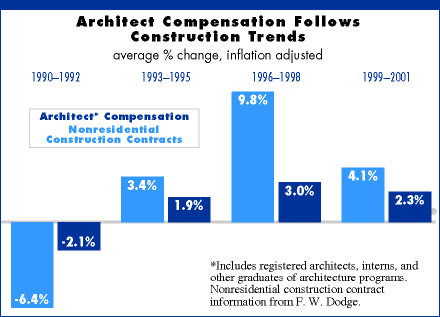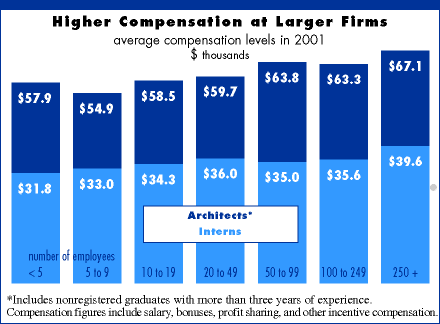

by Kermit Baker, PhD, Hon. AIA
AIA Chief Economist
Compensation at architecture firms has continued to increase at a healthy pace in recent years, despite a slowdown in the economy throughout most of 2001 and early 2002 and only modest increases in compensation throughout the overall economy over this timeframe. However, the economic slowdown did not affect some sectors as much as others. For instance, residential construction, normally a sector that falls during even a mild economic downturn, has continued to expand during the recent period of economic weakness. Residential construction is not only a large segment of the economy but also an important market for many architecture firms.
Low rates of inflation have generated favorable financing costs for construction activities and in turn healthy levels of construction activity—and therefore design activity—at U.S. architecture firms. With the increasing workloads of firms, compensation for most positions has increased at a healthy pace.
 In
recent years, compensation for architecture positions (including registered
architects, nonregistered graduates of architecture programs, and graduates
currently working in internship programs) has grown well in excess of
inflation in the overall economy. Architect compensation is broadly defined
to include salary, overtime, bonuses, profit sharing, and other incentive
compensation. Average compensation for architecture positions as of early
2002 was 15% above what it would be if it had merely kept pace with inflation
since 1990. These increases are in marked contrast to the early 1990s,
when architect compensation failed to keep pace with inflation. As recently
as 1996, compensation levels were below 1990 levels adjusted for the effects
of inflation.
In
recent years, compensation for architecture positions (including registered
architects, nonregistered graduates of architecture programs, and graduates
currently working in internship programs) has grown well in excess of
inflation in the overall economy. Architect compensation is broadly defined
to include salary, overtime, bonuses, profit sharing, and other incentive
compensation. Average compensation for architecture positions as of early
2002 was 15% above what it would be if it had merely kept pace with inflation
since 1990. These increases are in marked contrast to the early 1990s,
when architect compensation failed to keep pace with inflation. As recently
as 1996, compensation levels were below 1990 levels adjusted for the effects
of inflation.
Not surprisingly, trends in compensation at U.S. architecture firms track the general health of the construction industry. An upturn in construction activity—particularly in the nonresidential sector—means more work for architecture firms, a need for growth in architecture staff, and generally improved profitability. These factors typically produce increases in compensation, either through opportunities for advancement in firms or through higher compensation for a given position.
Periods when construction activity is rapidly expanding—for example, 1996 to 1998—generally are times when compensation is increasing the fastest. During this period, compensation for architecture staff increased an average of 3% per year in excess of the rate of inflation. When construction activity declines—as was true in the early 1990s—architect compensation also declines slightly once inflation is factored in. Since 1999, nonresidential construction activity has grown more modestly than it did from 1996 to 1998, and compensation gains, likewise, have been more modest.

Compensation gains for architecture staff have moderated in recent years. Still, these gains have outpaced those in the broader economy. Across all architecture positions, increases averaged almost 5.5% annually between 1999 and 2001 (2.3% after adjusting for inflation). Salaries for professional, specialty, and technical occupations increased 3.9% per year on average between 1999 and 2001 (the same growth rate as all private-sector compensation), according to U.S. Department of Labor data.
Larger firms generally
offer higher compensation
Studies of architecture firm characteristics (e.g., AIA Firm Survey 2000–2002)
have shown that larger firms generally have higher billings per employee.
Some portion of these higher billings translates into higher compensation
levels. Compensation of architecture staff is typically about 15% higher
at larger firms than at smaller firms and about 5–10% higher at larger
firms than at midsize firms. These differences in compensation do not
include differentials in fringe benefits offered by firms. Compensation
differences also do not capture advancement opportunities and job satisfaction
levels that may differ between larger and smaller firms.

Differentials in compensation also typically exist between firms located in major metropolitan areas and firms located just beyond the fringe of metropolitan areas or in smaller cities, towns, or rural areas. On average, compensation at firms located in metropolitan areas is about 10% higher than for comparable positions at firms in nonmetropolitan areas in the same region of the country.
As with staff positions, compensation for principals and partners generally is significantly higher at larger firms. On average, these positions command compensation levels about 50% higher at firms with 50 or more employees compared to firms with fewer than 50 employees. This gap widens for the more senior positions: Senior principals and partners at firms with 50 or more employees (often with titles of president, CEO, or managing partner) have average compensation levels 75% higher than comparable titles at firms with fewer than 50 employees.
Whereas principal and partner positions at firms offer higher compensation, a higher portion of that compensation generally depends on the financial performance of the firm. For registered and nonregistered graduate architecture staff, an average of 10% of compensation came from nonguaranteed bonuses, profit sharing, overtime, and other incentive compensation. For architecture interns and students, an average of 7% of compensation came from these nonguaranteed sources. For principals and partners, more than 25% of compensation on average was not guaranteed.
Copyright 2002 The American Institute of Architects. All rights reserved.
![]()
|
"The full Compensation Report and the nine regional reports are now available for purchase from the AIA Bookstore online. The printed version will be available the last week in October from the AIA Bookstore; phone 800-242-3837 option #4; fax 202-626-7519. |
|